Scoby mixed¶
Research made with Lauriane Beaumont.
When we collect scoby sometimes is not really perfect for using it plain. With Lauriane we decided to mix it for making a new medium and adding on it others materials for changing the aspect and properties.
Mixing scoby is inspire by the article Mechanical characteristics of bacterial cellulose-reinforced mycelium composite materials Authors: Elise Elsacker, Simon Vandelook, Bastien Damsin and Aurélie Van Wylick
| Material | Details |
|---|---|
| Ingredients | Scoby of kombucha, Ink with Ethanol, Natural bath of dying, Iron, Glycerol |
| Tools | Scissors, Mixer, Balance, Spoon, Non-porous surface |
Kombucha mixed with dying color : 21/02/2023 to the 28/02/2023¶
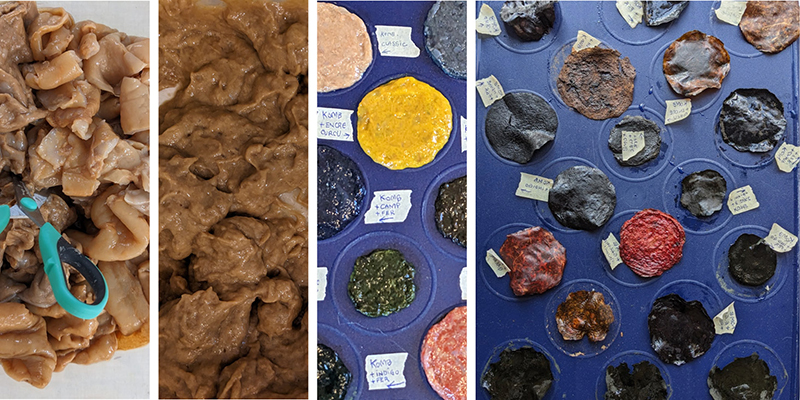
| Microbial species | Origine | Feedstock | Drying method | Post traitment |
|---|---|---|---|---|
| Mixed SCOBY of Kombucha | Pierre and Charles « La Pieuvre Noire kombucha», Lyon | spoon of SCOBY mixed + different test of natural color bath | Natural drying | Glycerol |


| The different test made |
|---|
| SCOBY mixed |
| SCOBY mixed + iron |
| SCOBY mixed + campeche |
| SCOBY mixed + campeche + iron |
| SCOBY mixed + tumeric ethanol ink |
| SCOBY mixed + tumeric ethanol ink + iron |
| SCOBY mixed + henne powder |
| SCOBY mixed + henne powder + iron |
| SCOBY mixed + indigo powder |
| SCOBY mixed + indigo powder + iron |
| SCOBY mixed + indigo powder + tumeric ethanol ink |
| SCOBY mixed + garance powder |
| SCOBY mixed + santal ethanol ink |
| SCOBY mixed + santal ethanol ink + iron |
Cut the SCOBY with the scissor
Mix it with the hand mixer
Add some colors on it
Option: Add some iron for changing the color
Put the mixture on the non-porous surface
Wait till it be dry
Add glycerol on it
IRON
Becareful when you change to sample to another to mixing it or adding glycerol on it. Iron stay on the fingers, ustensils, everything...
We had troubles with it! Some iron go with sample who originally didn't have. This changing our samples...
- Mixing SCOBY with the hand mixer
- Adding some garance powder on SCOBY
- Mixing campeche + iron
- Adding iron on the tumeric ethanol ink
Results¶
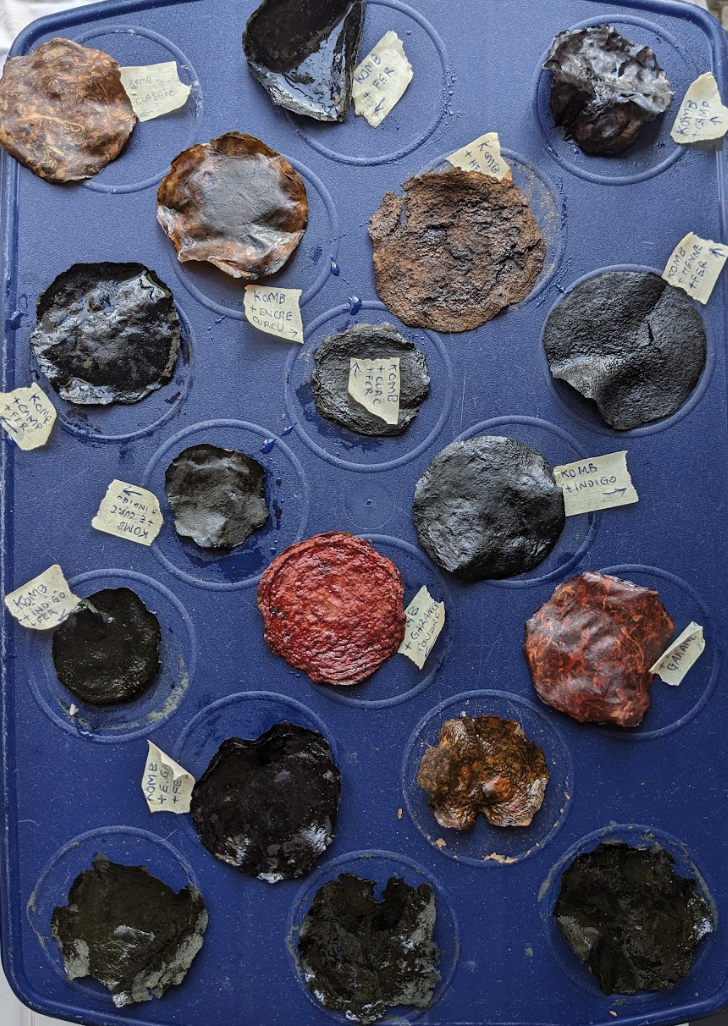
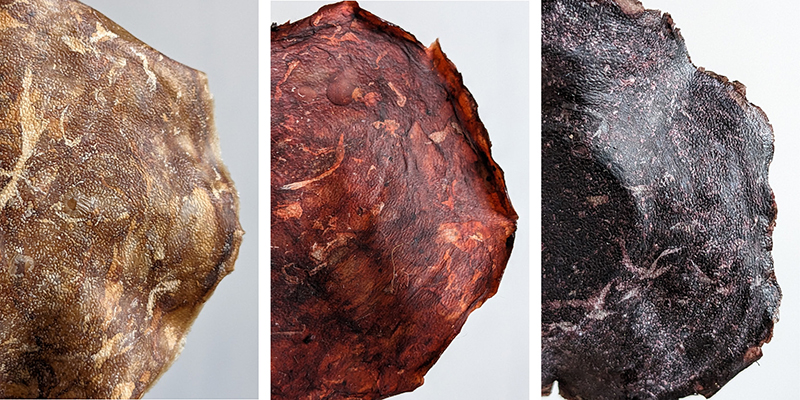
- SCOBY mixed
- SCOBY mixed + santal ethanol ink
- SCOBY mixed + campeche + iron
R E D¶
Following this research and the collaboration, Lauriane like the result with santal ink and she decide to make a big piece of art with this.
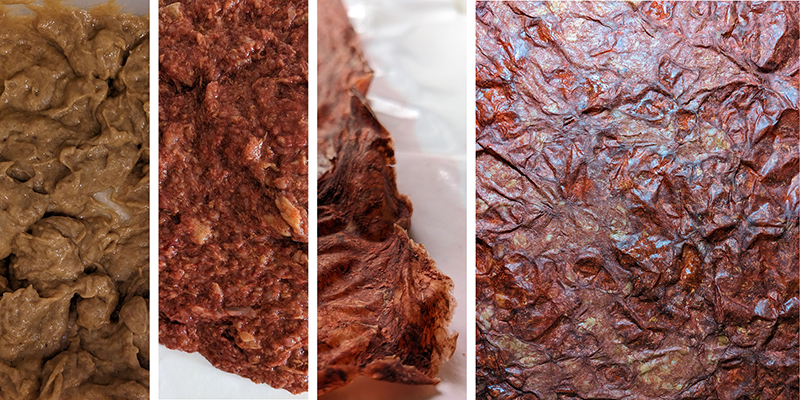
| Microbial species | Origine | Feedstock | Drying method | Post traitment | Dimensions | Application |
|---|---|---|---|---|---|---|
| Mixed SCOBY of Kombucha | Pierre and Charles « La Pieuvre Noire kombucha», Lyon | 1,5kg of SCOBY+ 100cl ethanol santal ink 0,750ml santal bath | Natural drying | Glycerol | Before drying : 66cm X 83cm After drying : 55cm X 74cm | Piece of art |
- Using spatule when SCOBY it's not totally dry to start peeling it off
- SCOBY SCOBY lift off the surface, changing of the luminosity
Molded with vacuum¶
The aim was to see the reaction of the SCOBY mixed for arriving to mold it. Following the week 9- Textile Scafold
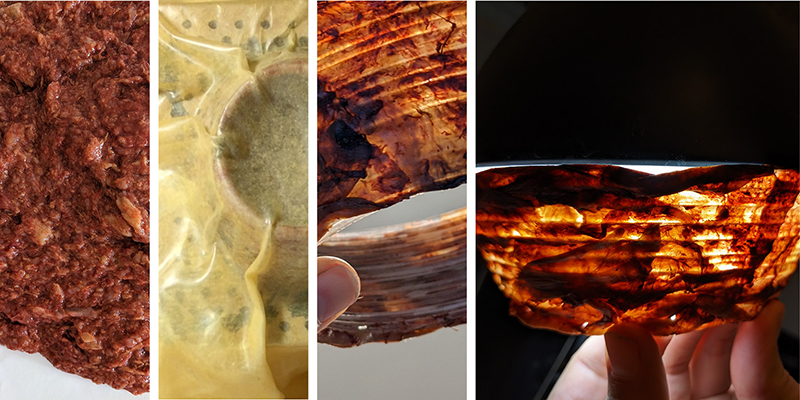
Using excess of the RED scoby mixed.
Adding the paste layers on the mold
I didn't use the textile fabric due to the SCOBY really sticky.
Results and remarks¶
Application of colors
Dyeing or adding material must be as little wet as possible to avoid a long drying time. The color in the Coment depending on how it injects into the material it will change the property of the material, its appearance, its density, its elasticity, its strength, its brittleness, its transparency.
We remarks it’s better to tint on whole kombucha before mixing.
It can be added:
- liquid: bath or dye ink
- paste: powder mixed with water (henna or indigo powder) The material is mixed and will act as a filler. We do not remove the surplus of dye bath or henna powder. It becomes an addition of matter and a new component of the material. The eco print with St. John’s wort did not work well. The fibers of the plant stick to the scoby.
Dying
Use a non-porous surface, a textile surface will make it stick and it will be difficult to remove. The dye has a tendency to bleed from the scoby. Mixed kombucha is more fragile, to dry faster it would need an additional drying system. When drying, kombucha becomes brittle and fragile. To avoid this, glycerine is applied to the kombucha during the last phase of drying to make it more supple and strong. The water will bring back the moisture in a given time and then evaporate.
Properties
Once mixed, the kombucha becomes very fine and it would be impossible to separate the matter and the colors put in it. By remoistening the kombucha it becomes soft, it is then possible to remodel it and to stick it on itself to create a new product. By giving it an adapted hydration rate to soften it without disintegrating it. It becomes malleable enough to be worked in layers for example. It is naturally glued on itself. Spread by hand 5mm thick on a waxed canvas. The waxed canvas will also take the color.
Before drying
For the " RED" : We notice a non uniform retraction due to the fact that the material dries differently on the edges compared to the surface of the sheet. For the recipe the edges dry faster than the center of the sheet. It will be necessary to take into consideration the addition of an artificial drying for a more uniform drying and thus avoid the cracks